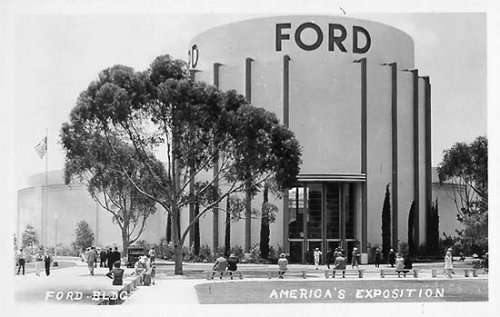Wednesday 29th May 1935
The Ford Motor Company pavilion, designed by Walter Dorwin Teague, opened at the California-Pacific Exposition in San Diego, California, US.
Ford was the exposition’s principal exhibitor and invested $2 million in the 45,000-square-foot (4,200 m2), 296-foot (90 m) diameter building to showcase its vehicles and other forms of transportation.[6] Throughout the Exposition, Ford was assembling autos along the outer rings and used the courtyard area to display the latest model automobiles. The newly assembled vehicles were rolled out the large doors on the west side. There was also a test track set up down the hill behind the building where visitors could take one of the model autos for a test drive.
By the end of the exhibition, 2.5 million people had toured the building and its exhibits.[8] Ford donated the building to the city of San Diego at the exhibition’s completion in November 1935. The city decided to extend the exhibition into 1936 and renamed the building “The Palace of Transportation” to showcase exhibits related to transportation. When the 1936 exhibition concluded, the building was closed and was not available to the public until 1980 when the San Diego Air & Space Museum opened.
With the building empty, the National Guard temporarily stored anti-aircraft artillery, trucks, and searchlights.[11] During World War II, Balboa Park was renamed to Camp Kidd, to be used for U.S. Navy training, barracks, and hospital wards. The Ford Building was used for training mechanics in aircraft repair and welding from 1941 to 1946. Convair considered using the building for construction of B-24 Liberators until they realized the building was too small to fit the plane’s extensive wingspan.
From the late 1940s to the 1960s, the building was used for storage for both the Starlight Civic Opera and San Diego’s Park and Recreation department. By this point the building was in poor shape and was recommended by a 1960 commission to demolish the building. Several San Diego groups instead worked to get the building listed on the National Register of Historic Places in 1973, saving it from being destroyed. It currently serves as the home of the San Diego Air & Space Museum.






